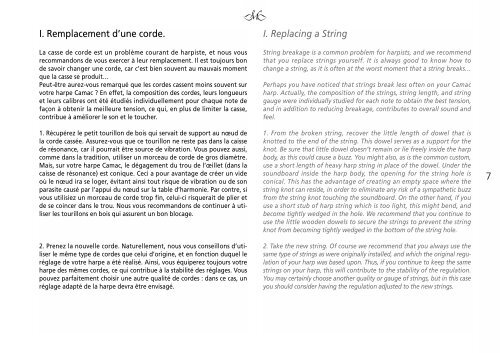Manuel d'Entretien Owner's Manual - les harpes camac
Manuel d'Entretien Owner's Manual - les harpes camac
Manuel d'Entretien Owner's Manual - les harpes camac
- No tags were found...
Create successful ePaper yourself
Turn your PDF publications into a flip-book with our unique Google optimized e-Paper software.
I. Remplacement d’une corde.La casse de corde est un problème courant de harpiste, et nous vousrecommandons de vous exercer à leur remplacement. Il est toujours bonde savoir changer une corde, car c’est bien souvent au mauvais momentque la casse se produit…Peut-être aurez-vous remarqué que <strong>les</strong> cordes cassent moins souvent survotre harpe Camac ? En effet, la composition des cordes, leurs longueurset leurs calibres ont été étudiés individuellement pour chaque note defaçon à obtenir la meilleure tension, ce qui, en plus de limiter la casse,contribue à améliorer le son et le toucher.1. Récupérez le petit tourillon de bois qui servait de support au nœud dela corde cassée. Assurez-vous que ce tourillon ne reste pas dans la caissede résonance, car il pourrait être source de vibration. Vous pouvez aussi,comme dans la tradition, utiliser un morceau de corde de gros diamètre.Mais, sur votre harpe Camac, le dégagement du trou de l’œillet (dans lacaisse de résonance) est conique. Ceci a pour avantage de créer un videoù le nœud ira se loger, évitant ainsi tout risque de vibration ou de sonparasite causé par l’appui du nœud sur la table d’harmonie. Par contre, sivous utilisiez un morceau de corde trop fin, celui-ci risquerait de plier etde se coincer dans le trou. Nous vous recommandons de continuer à utiliser<strong>les</strong> tourillons en bois qui assurent un bon blocage.2. Prenez la nouvelle corde. Naturellement, nous vous conseillons d’utiliserle même type de cordes que celui d’origine, et en fonction duquel leréglage de votre harpe a été réalisé. Ainsi, vous équiperez toujours votreharpe des mêmes cordes, ce qui contribue à la stabilité des réglages. Vouspouvez parfaitement choisir une autre qualité de cordes : dans ce cas, unréglage adapté de la harpe devra être envisagé.I. Replacing a StringString breakage is a common problem for harpists, and we recommendthat you replace strings yourself. It is always good to know how tochange a string, as it is often at the worst moment that a string breaks…Perhaps you have noticed that strings break <strong>les</strong>s often on your Camacharp. Actually, the composition of the strings, string length, and stringgauge were individually studied for each note to obtain the best tension,and in addition to reducing breakage, contributes to overall sound andfeel.1. From the broken string, recover the little length of dowel that isknotted to the end of the string. This dowel serves as a support for theknot. Be sure that little dowel doesn’t remain or lie freely inside the harpbody, as this could cause a buzz. You might also, as is the common custom,use a short length of heavy harp string in place of the dowel. Under thesoundboard inside the harp body, the opening for the string hole isconical. This has the advantage of creating an empty space where thestring knot can reside, in order to eliminate any risk of a sympathetic buzzfrom the string knot touching the soundboard. On the other hand, if youuse a short stub of harp string which is too light, this might bend, andbecome tightly wedged in the hole. We recommend that you continue touse the little wooden dowels to secure the strings to prevent the stringknot from becoming tightly wedged in the bottom of the string hole.2. Take the new string. Of course we recommend that you always use thesame type of strings as were originally installed, and which the original regulationof your harp was based upon. Thus, if you continue to keep the samestrings on your harp, this will contribute to the stability of the regulation.You may certainly choose another quality or gauge of strings, but in this caseyou should consider having the regulation adjusted to the new strings.7
















